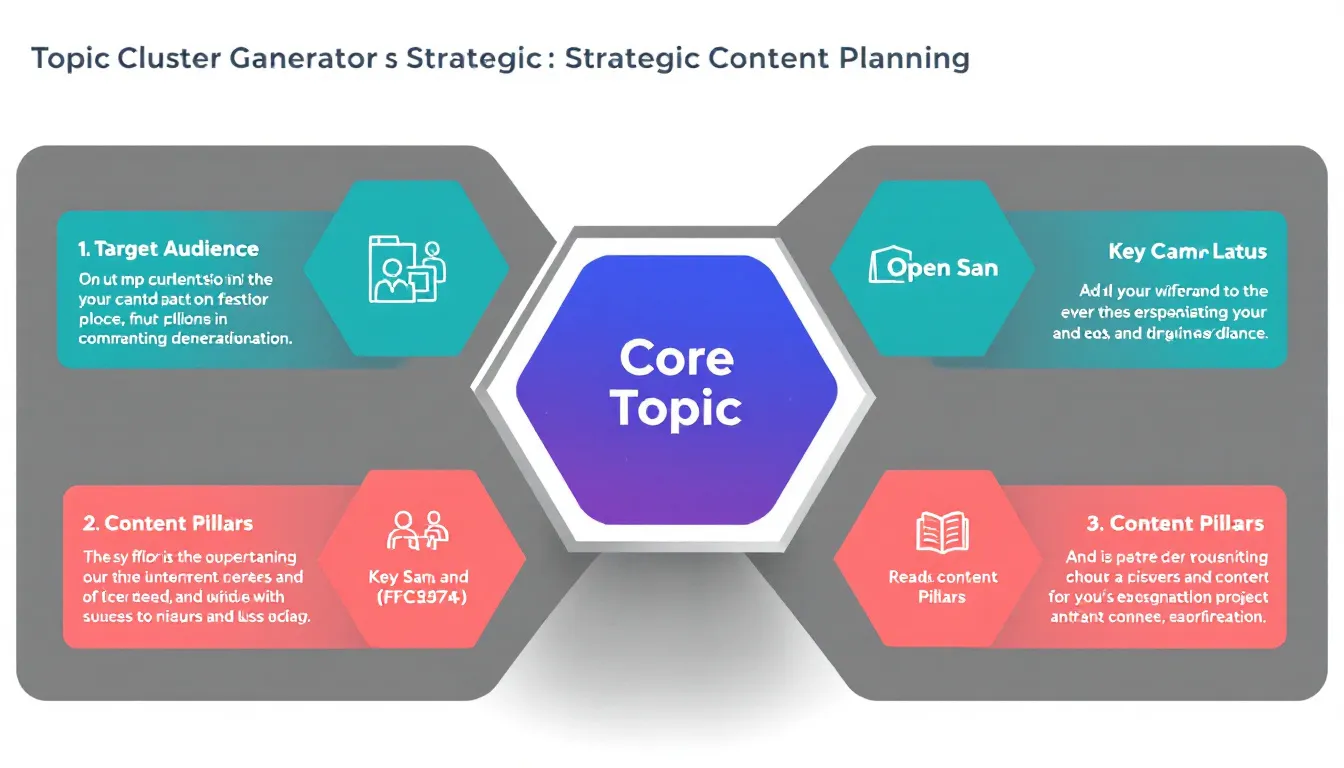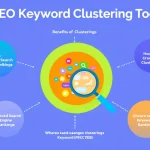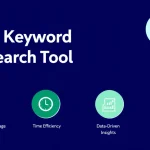Is this tool helpful?
How to Use the Topic Cluster Generator Tool Effectively
Our Topic Cluster Generator tool streamlines your content strategy planning process by suggesting relevant topic clusters based on your business information. Here’s a detailed guide on using each field:
Step-by-Step Input Guide
- Business Name: Enter your company name clearly. For example: “TechGrow Solutions” or “Wellness Warriors”
- Business Description: Provide comprehensive details about your business operations. Example: “We provide enterprise-level cybersecurity solutions for healthcare organizations, specializing in HIPAA compliance and data protection” or “We offer personalized nutrition coaching and wellness programs for busy professionals”
- Main Business Objectives: List specific goals. Example: “Establish thought leadership in cybersecurity, generate qualified leads from healthcare providers, and increase market share by 25%” or “Build brand awareness in the corporate wellness sector, acquire 500 new coaching clients, and launch a digital wellness platform”
- Target Audience Details: Define your audience precisely. Example: “Healthcare IT directors and compliance officers in mid to large-sized hospitals, aged 35-55” or “Corporate professionals aged 28-45 working in high-stress environments seeking work-life balance”
- Industry Keywords: Include relevant terms. Example: “HIPAA compliance, healthcare security, data protection, medical records security” or “corporate wellness, stress management, nutrition coaching, workplace health”
Understanding Topic Cluster Generation for Content Strategy
Topic clustering is a strategic content organization method that helps businesses create comprehensive, interconnected content that demonstrates expertise and improves search engine visibility. The tool analyzes your inputs to generate thematically related content groups that align with your business goals and audience needs.
Core Components of Topic Clusters
- Pillar Content: In-depth, comprehensive content pieces
- Supporting Content: Related subtopics that link to the pillar
- Internal Linking Structure: Strategic connections between content pieces
- Keyword Integration: Relevant terms that connect topics
Benefits of Using the Topic Cluster Generator
Strategic Advantages
- Improved Content Organization: Creates logical content hierarchies
- Enhanced SEO Performance: Strengthens topical authority
- Better User Experience: Provides clear content pathways
- Efficient Content Planning: Streamlines editorial calendar development
- Competitive Edge: Identifies content gaps and opportunities
Business Impact
- Increased Organic Traffic: Through improved search visibility
- Higher Conversion Rates: From more targeted content
- Reduced Content Overlap: Better resource utilization
- Stronger Brand Authority: Comprehensive topic coverage
Problem-Solving Applications
Common Content Strategy Challenges Addressed
- Content Fragmentation: Creates cohesive content structures
- Topic Selection: Identifies valuable content opportunities
- Resource Allocation: Prioritizes content creation efforts
- Audience Alignment: Ensures content meets user needs
Strategic Implementation
The tool helps solve specific content strategy problems through systematic analysis:
- Identifies content gaps in your current strategy
- Suggests complementary topics for comprehensive coverage
- Aligns content with business objectives
- Maps user journey touchpoints
Practical Applications and Use Cases
Industry-Specific Examples
E-commerce Business
Input: Online sustainable fashion retailer
Generated Clusters:
- Sustainable Fashion Materials
- Ethical Manufacturing Processes
- Fashion Industry Environmental Impact
- Conscious Consumer Guides
- Sustainable Style Tips
SaaS Company
Input: Project management software provider
Generated Clusters:
- Remote Team Management
- Project Planning Methodologies
- Productivity Tools and Integration
- Team Collaboration Strategies
- Resource Allocation Best Practices
Frequently Asked Questions
General Questions
Q: How many topic clusters should I create for my content strategy?
A: The ideal number depends on your business scope and resources. Start with 3-5 core clusters and expand based on content performance and business growth.
Q: How often should I update my topic clusters?
A: Review and update your topic clusters quarterly to ensure alignment with business objectives and market trends.
Q: Can I use the generated clusters for different content formats?
A: Yes, topic clusters can be adapted for various content formats including blogs, videos, podcasts, and social media content.
Implementation Questions
Q: How do I prioritize which topic cluster to develop first?
A: Choose clusters that align with your immediate business goals and have the highest potential impact on your target audience.
Q: Should all content within a cluster be created simultaneously?
A: No, develop your pillar content first, then gradually create supporting content pieces according to your content calendar and resources.
Q: How do I measure the success of my topic clusters?
A: Track metrics such as organic traffic, time on page, conversion rates, and internal link engagement for cluster content.
Strategic Questions
Q: Can I combine multiple topic clusters?
A: Yes, clusters can overlap and interconnect when there are natural relationships between topics.
Q: How detailed should my business description be for better results?
A: Provide specific information about your products/services, target market, and unique value proposition for more targeted cluster suggestions.
Q: Can I modify the suggested topic clusters?
A: Yes, consider the generated clusters as a strategic foundation that you can customize based on your specific needs and industry expertise.
Content Development Questions
Q: What makes a good pillar page for a topic cluster?
A: A comprehensive, authoritative piece that covers the main topic broadly while linking to more specific supporting content.
Q: How do I maintain consistency across cluster content?
A: Develop a content style guide and maintain consistent messaging, tone, and terminology across all cluster content.
Q: Can I repurpose existing content into topic clusters?
A: Yes, audit your existing content and reorganize it into clusters, filling gaps with new content as needed.
Important Disclaimer
The calculations, results, and content provided by our tools are not guaranteed to be accurate, complete, or reliable. Users are responsible for verifying and interpreting the results. Our content and tools may contain errors, biases, or inconsistencies. We reserve the right to save inputs and outputs from our tools for the purposes of error debugging, bias identification, and performance improvement. External companies providing AI models used in our tools may also save and process data in accordance with their own policies. By using our tools, you consent to this data collection and processing. We reserve the right to limit the usage of our tools based on current usability factors. By using our tools, you acknowledge that you have read, understood, and agreed to this disclaimer. You accept the inherent risks and limitations associated with the use of our tools and services.







